|
The town of
Collegeport
was established on
May
25, 1908
by the Burton D. Hurd Land Company.
Land was provided for the establishment of the Gulf Coast
University of Industrial Arts, and it was planned that the Pilkington
Slough be dredged for a port just south of the town.
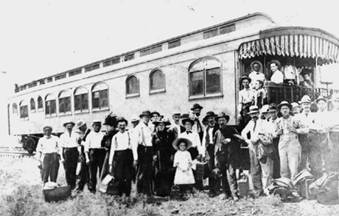
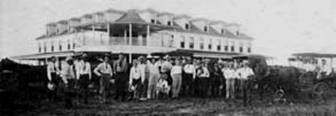
Excursion
cars brought investors and settlers mainly from the mid-western states
to buy land and start businesses. Businesses, churches and schools were
established. The Collegeport Industrial League took the initiative in
arranging for a special tax and later for the voting of bonds to build
the brick schoolhouse. Organizing
the school was the principle act of the first meeting of the League in
1910.
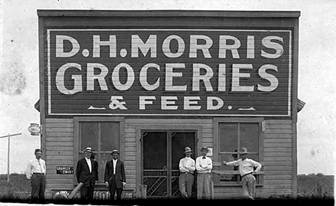
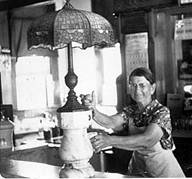
The port never materialized, and the university thrived just a short
while before the economy failed in the young community.
Despite the hopes of Collegeport being a dynamic center of
commerce and education, economics of production plagued the early
settlers. The Gulf Coast
University of Industrial Arts planted orchards and crops utilizing
student labor in exchange for tuition.
Pioneers experimented in order to find viable crops which would
produce in the area. Rail
service into the community brought hope that this would open markets for
local products.
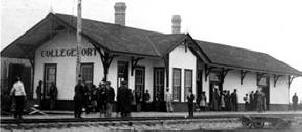
Collegeport
Depot ca. 1910

Rice Warehouse
Dairy products, eggs and other farm-raised
commodities were marketed.
On one occasion, watermelons were shipped and all that was
gleaned was a bill for freight.
By 1915, the university had closed; the Hotel Collegeport was vacant in
1916, and many of the original settlers had moved back from
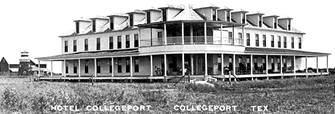
 whence
they came. In the 1920’s,
Dr. W. W. Van Wormer began the Collegeport Fig Orchards Company, which
thrived, but failed due to the depression.
Despite the hard times, a community spirit prevailed, and
residents thrived on that unity.
There were many opportunities for social engagement including barn
dances, box socials, concerts and dances on the pavilion, community
fairs, New Years Day and Washington’s Birthday Banquets, and of course
the annual homecoming celebration—Collegeport Day.
Civic and church organizations included the Industrial League,
Mopac House Foundation, Woman’s Club, Women’s
Union
, King’s Daughters (who maintained the Cemetery) and the Princes of
Jonathan (Young Men’s Sunday School Class).
The advent of a paved road into the community, and improved
transportation brought about the end of rail service to Collegeport.
H. A. Clapp was instrumental in securing a gift of the railroad
depot to the community for the use as a Community House.
Mopac House was constructed of materials salvaged from the
Collegeport Depot, and opened on
May 4, 1935
. The Community House was
now the place the community gathered.
Before that time, the
Federated
Church
building was the center of community affairs, having also served as the
community’s early schoolhouse. whence
they came. In the 1920’s,
Dr. W. W. Van Wormer began the Collegeport Fig Orchards Company, which
thrived, but failed due to the depression.
Despite the hard times, a community spirit prevailed, and
residents thrived on that unity.
There were many opportunities for social engagement including barn
dances, box socials, concerts and dances on the pavilion, community
fairs, New Years Day and Washington’s Birthday Banquets, and of course
the annual homecoming celebration—Collegeport Day.
Civic and church organizations included the Industrial League,
Mopac House Foundation, Woman’s Club, Women’s
Union
, King’s Daughters (who maintained the Cemetery) and the Princes of
Jonathan (Young Men’s Sunday School Class).
The advent of a paved road into the community, and improved
transportation brought about the end of rail service to Collegeport.
H. A. Clapp was instrumental in securing a gift of the railroad
depot to the community for the use as a Community House.
Mopac House was constructed of materials salvaged from the
Collegeport Depot, and opened on
May 4, 1935
. The Community House was
now the place the community gathered.
Before that time, the
Federated
Church
building was the center of community affairs, having also served as the
community’s early schoolhouse.

Irrigation
Plant
Rice
production was introduced in the area after irrigation facilities were completed.
A large rice warehouse was built to store the grain which was
shipped out by rail.
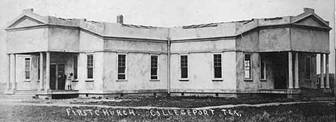
First
Church
of
Collegeport—Federated
Collegeport became primarily a rural, agricultural community whose
products included rice, cattle, grain and cotton.
The
Bay
View
Consolidated
School District
consolidated with the
Palacios
School District
in 1947 and the school building was demolished in the 1950’s.
Development of natural gas fields came about in the 1940’s when Brazos
Oil and Gas established its operations here.
Apache Corporation currently operates the field which is now depleted,
with the exception of a couple of producing wells.
In September of 1961, Hurricane Carla devastated the area and
destroyed the remaining business houses in Collegeport, namely the
Mowery Store and the Collegeport Pharmacy, including Miss Hattie’s soda
fountain. The U. S. Post Office has been maintained through the years,
and the Mopac House and Library still serve as the community center.
There are two active churches in the community, the
First
Baptist
Church
, established in 1949 and the First Presbyterian Church which evolved
from the First Church of Collegeport—Federated which was established in
1910.
The Collegeport Area Volunteer Fire Department was established in
1965. More recently,
aquaculture operations producing cultivated shrimp and fish have been on
the increase, as conventional agriculture has declined.
The Nature Conservancy of Texas acquired the Clive Runnells Mad
Island Marsh Preserve and maintains offices here.
Also, the
Texas
Parks
and Wildlife Dept. has a preserve near
Mad
Island
. Several families have
weekend homes here and consider Collegeport their community, too.
Collegeport continues to observe its founding day with annual
celebrations now held the last Saturday in May.
|







 whence
they came.
whence
they came.
